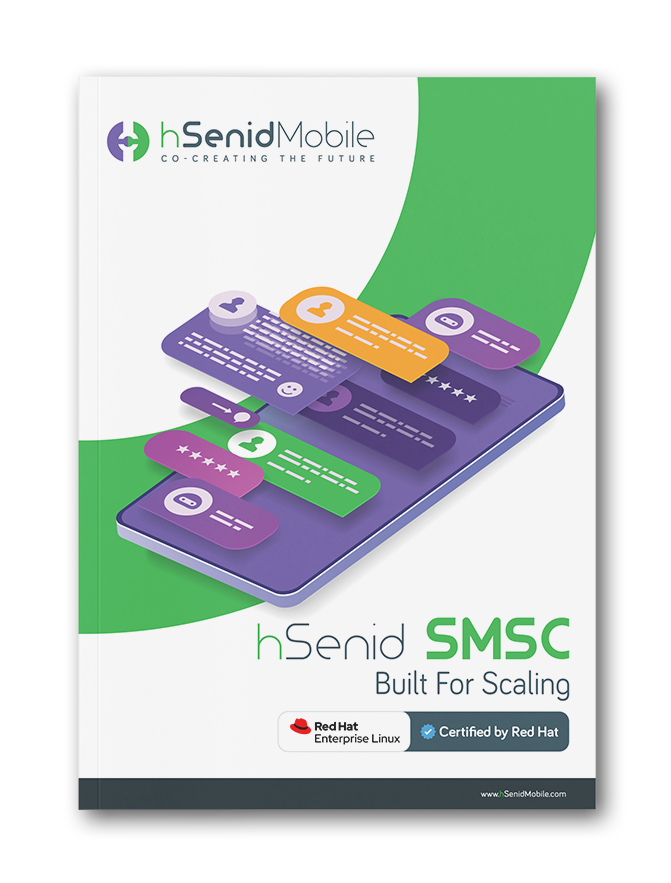In a fast-evolving telecommunications landscape, every decision a CIO makes carries long-term consequences. The Short Message Service Center (SMSC) may seem like a legacy piece of infrastructure, but it remains the core engine behind millions of daily transactions, alerts, and enterprise communications. As traffic volumes soar, 5G emerges, and enterprise messaging expands, legacy SMSC platforms are increasingly unable to meet today’s demands.
Before approving any upgrade, CIOs must pause and ask the right questions. The real challenge is not whether to upgrade, but how strategically to approach the transformation.
Legacy platforms often suffer from:
A next-generation SMSC platform such as hSenid’s carrier-grade, Red Hat certified SMSC is built for scalability, reliability, and operational efficiency. It empowers operators to reduce total cost of ownership, maximize throughput, and minimize service disruption. To ensure success, CIOs need clarity on which questions to ask before investing in an upgrade.
CIOs must ask: Does the SMSC guarantee no single point of failure?
The ideal solution must offer clustered architecture with internal load balancing and redundancy. hSenid SMSC ensures uninterrupted message flow even during system faults by executing automatic failover mechanisms. This internal resilience ensures every message is delivered without delay or loss.
Continuous uptime is a baseline expectation in high-volume network environments, not a feature.
CIOs must ask: Can the SMSC scale dynamically with changing business demand?
A future-ready system supports both vertical scaling (enhancing existing resources) and horizontal scaling (adding new nodes). hSenid SMSC delivers a modular and flexible architecture, enabling operators to expand capacity seamlessly without service interruption. This approach helps balance investment and performance while maintaining service quality.
Scalability means the SMSC grows as your business grows, without additional complexity or hardware constraints.
CIOs should ask: Is the SMSC built with an in-house SIGTRAN stack?
The hSenid SMSC integrates a proven in-house SIGTRAN stack, removing the need for expensive external solutions. This internal capability ensures tighter performance control, simplified integration, and reduced total cost of ownership.
Vendor independence also gives CIOs greater flexibility and long-term agility.
The essential question is: Does the SMSC support integration with IP-SM Gateways and 5G SMSF nodes?
The hSenid SMSC is fully equipped for 4G and 5G interworking. It connects seamlessly to IMS-enabled networks, allowing operators to continue leveraging SMS as a universal messaging channel across technologies.
This forward compatibility not only preserves existing investment but also opens new opportunities in IoT and enterprise messaging.
CIOs should ask: How does the platform ensure near-zero message loss?
The hSenid SMSC uses advanced delivery logic that minimizes message loss to nearly zero. Its forward and store method delivers messages first and stores them later, saving storage resources and improving performance.
This intelligent design guarantees consistent message delivery, even during traffic peaks or network congestion.
CIOs must ask: Does the platform have built-in overload protection?
The hSenid SMSC incorporates a sophisticated overload protection mechanism that dynamically buffers and redistributes traffic when delivery attempts exceed system thresholds. This ensures seamless message flow without downtime or data loss.
In environments handling millions of transactions per minute, such protection is critical to operational stability.
CIOs must ask: Does the system support real-time and offline charging for all subscriber types?
The hSenid SMSC supports both prepaid and postpaid charging models, including roaming users. It generates detailed call detail records (CDRs) for every transaction, providing a transparent foundation for revenue tracking and reporting.
This flexibility allows operators to monetize every message event accurately and integrate with existing billing systems easily.
CIOs should ask: Does the SMSC provide centralized, role-based management?
The hSenid SMSC includes a unified User Management Portal with single sign-on capabilities and role-based access control. It provides centralized access to SMSC Management, SMPP Gateway Management, and the Customer Care Portal.
The Customer Care Portal offers real-time CDR lookups, transaction summaries, and resource usage analytics. This consolidated visibility simplifies operations, reduces response time, and enhances governance.
CIOs must ask: Does the platform offer configurable routing and external API support?
hSenid SMSC enables dynamic routing through a graphical interface, allowing administrators to apply rules, relays, or reanalysis operations easily. In addition, it exposes APIs for external integrations, such as advertising engines or partner systems.
Its advertisement appending capability allows third-party systems to inject promotional messages into outgoing SMS, opening up new monetization opportunities without disrupting message flow.
CIOs should ask: Does the SMSC have built-in support for bulk traffic and SMPP clients?
The hSenid SMSC supports full SMPP protocol and can manage multiple ESME connections simultaneously. Its built-in bulk messaging portal allows enterprises to send large-scale campaigns efficiently while maintaining delivery assurance.
By consolidating enterprise traffic on a single, optimized platform, operators can ensure both performance and profitability.
The hSenid SMSC eliminates these inefficiencies with its in-house SIGTRAN stack and modular architecture. This approach significantly lowers long-term costs and reduces maintenance overhead.
Over a five-year horizon, operators can achieve cost savings exceeding 30 percent (Source: hSenid R&D). Vendor independence also empowers CIOs to maintain control over performance and innovation cycles.
An intelligent, scalable platform transforms an SMSC from a message relay node into a strategic enabler that drives innovation. With a robust SMSC in place, operators gain several benefits:
This transformation allows CIOs to reframe messaging infrastructure as a growth catalyst, not a maintenance burden.
In contrast, a clustered SMSC like hSenid’s dynamically distributes traffic, buffers overload, and maintains delivery consistency. The operator not only ensures message integrity but also monetizes the increased traffic volume efficiently.
Such scalability turns a potential challenge into a predictable, profitable opportunity.
Asking these questions ensures that the SMSC investment aligns with business growth, operational resilience, and long-term cost efficiency.
A future-ready SMSC platform must therefore combine scalability, intelligence, and adaptability. hSenid’s platform, built with modularity and integration-first principles, empowers operators to innovate, scale, and optimize with confidence.
The CIOs who embrace this transformation today will lead networks that remain relevant, resilient, and revenue-driven tomorrow.
The right platform should enhance reliability, deliver real-time analytics, support next-generation technologies, and reduce costs through architectural intelligence.
CIOs who ask the right questions now will position their organizations for continuous innovation and success.
Explore how the hSenid SMSC platform transforms network reliability and scalability. Talk to us about implementing this solution today.
Before approving any upgrade, CIOs must pause and ask the right questions. The real challenge is not whether to upgrade, but how strategically to approach the transformation.
Why an SMSC Upgrade Is No Longer Optional
Every year, mobile operators process billions of SMS messages that underpin critical services such as financial alerts, one-time passwords (OTPs), and IoT notifications. Yet, many traditional SMSCs are struggling to keep pace with modern traffic patterns and interoperability requirements.Legacy platforms often suffer from:
- Limited scalability
- Higher operational expenses
- Downtime during peak hours
- Compatibility issues with newer 4G and 5G systems
A next-generation SMSC platform such as hSenid’s carrier-grade, Red Hat certified SMSC is built for scalability, reliability, and operational efficiency. It empowers operators to reduce total cost of ownership, maximize throughput, and minimize service disruption. To ensure success, CIOs need clarity on which questions to ask before investing in an upgrade.
1. Is the Platform Architected for True High Availability?
Downtime is no longer acceptable in telecom operations. Message delivery failures directly translate into revenue loss and damaged reputation.CIOs must ask: Does the SMSC guarantee no single point of failure?
The ideal solution must offer clustered architecture with internal load balancing and redundancy. hSenid SMSC ensures uninterrupted message flow even during system faults by executing automatic failover mechanisms. This internal resilience ensures every message is delivered without delay or loss.
Continuous uptime is a baseline expectation in high-volume network environments, not a feature.
2. Can It Scale Both Vertically and Horizontally?
Traffic surges are no longer seasonal or predictable. Enterprise clients, social campaigns, and A2P traffic can suddenly multiply network load.CIOs must ask: Can the SMSC scale dynamically with changing business demand?
A future-ready system supports both vertical scaling (enhancing existing resources) and horizontal scaling (adding new nodes). hSenid SMSC delivers a modular and flexible architecture, enabling operators to expand capacity seamlessly without service interruption. This approach helps balance investment and performance while maintaining service quality.
Scalability means the SMSC grows as your business grows, without additional complexity or hardware constraints.
3. Does It Offer In-House Integration Capabilities?
Third-party dependencies often become a financial and operational burden over time. Legacy SMSCs that rely on external SIGTRAN stacks or SS7 cards add licensing costs and complexity.CIOs should ask: Is the SMSC built with an in-house SIGTRAN stack?
The hSenid SMSC integrates a proven in-house SIGTRAN stack, removing the need for expensive external solutions. This internal capability ensures tighter performance control, simplified integration, and reduced total cost of ownership.
Vendor independence also gives CIOs greater flexibility and long-term agility.
4. How Well Does It Support 4G and 5G Interworking?
As operators migrate to IP-based networks, SMS interworking becomes a critical capability.The essential question is: Does the SMSC support integration with IP-SM Gateways and 5G SMSF nodes?
The hSenid SMSC is fully equipped for 4G and 5G interworking. It connects seamlessly to IMS-enabled networks, allowing operators to continue leveraging SMS as a universal messaging channel across technologies.
This forward compatibility not only preserves existing investment but also opens new opportunities in IoT and enterprise messaging.
5. Is Message Delivery Optimized for Real-Time Performance?
High throughput is vital, but reliability defines the customer experience.CIOs should ask: How does the platform ensure near-zero message loss?
The hSenid SMSC uses advanced delivery logic that minimizes message loss to nearly zero. Its forward and store method delivers messages first and stores them later, saving storage resources and improving performance.
This intelligent design guarantees consistent message delivery, even during traffic peaks or network congestion.
6. Can It Prevent Overload and Maintain Throughput Integrity?
Traffic overload can cripple networks and degrade service quality.CIOs must ask: Does the platform have built-in overload protection?
The hSenid SMSC incorporates a sophisticated overload protection mechanism that dynamically buffers and redistributes traffic when delivery attempts exceed system thresholds. This ensures seamless message flow without downtime or data loss.
In environments handling millions of transactions per minute, such protection is critical to operational stability.
7. Is the Platform Ready for Comprehensive Billing and Charging?
Revenue assurance begins with accurate billing.CIOs must ask: Does the system support real-time and offline charging for all subscriber types?
The hSenid SMSC supports both prepaid and postpaid charging models, including roaming users. It generates detailed call detail records (CDRs) for every transaction, providing a transparent foundation for revenue tracking and reporting.
This flexibility allows operators to monetize every message event accurately and integrate with existing billing systems easily.
8. How Simple Is Management and Monitoring?
With multiple systems operating simultaneously, managing user access and monitoring system health can become complex.CIOs should ask: Does the SMSC provide centralized, role-based management?
The hSenid SMSC includes a unified User Management Portal with single sign-on capabilities and role-based access control. It provides centralized access to SMSC Management, SMPP Gateway Management, and the Customer Care Portal.
The Customer Care Portal offers real-time CDR lookups, transaction summaries, and resource usage analytics. This consolidated visibility simplifies operations, reduces response time, and enhances governance.
9. How Flexible Is Routing and API Connectivity?
A modern SMSC must be able to adapt quickly to new business models, routing rules, and integrations.CIOs must ask: Does the platform offer configurable routing and external API support?
hSenid SMSC enables dynamic routing through a graphical interface, allowing administrators to apply rules, relays, or reanalysis operations easily. In addition, it exposes APIs for external integrations, such as advertising engines or partner systems.
Its advertisement appending capability allows third-party systems to inject promotional messages into outgoing SMS, opening up new monetization opportunities without disrupting message flow.
10. Can It Handle Enterprise and Bulk Messaging Efficiently?
Enterprise and bulk messaging are critical revenue streams.CIOs should ask: Does the SMSC have built-in support for bulk traffic and SMPP clients?
The hSenid SMSC supports full SMPP protocol and can manage multiple ESME connections simultaneously. Its built-in bulk messaging portal allows enterprises to send large-scale campaigns efficiently while maintaining delivery assurance.
By consolidating enterprise traffic on a single, optimized platform, operators can ensure both performance and profitability.
Added Insight: Why TCO and Vendor Independence Matter
Total cost of ownership often defines the real success of an infrastructure upgrade. External dependencies, recurring licenses, and hardware upgrades can silently inflate operational expenses.The hSenid SMSC eliminates these inefficiencies with its in-house SIGTRAN stack and modular architecture. This approach significantly lowers long-term costs and reduces maintenance overhead.
Over a five-year horizon, operators can achieve cost savings exceeding 30 percent (Source: hSenid R&D). Vendor independence also empowers CIOs to maintain control over performance and innovation cycles.
The Strategic Shift: From Infrastructure to Innovation
Modernizing an SMSC is no longer just a technical upgrade. It represents a shift in how operators view their messaging infrastructure.An intelligent, scalable platform transforms an SMSC from a message relay node into a strategic enabler that drives innovation. With a robust SMSC in place, operators gain several benefits:
- Faster introduction of new enterprise services
- Full 5G compatibility and readiness for IoT expansion
- Real-time analytics for operational intelligence
- Flexible monetization through dynamic routing and ads
- Reduced downtime and optimized utilization
This transformation allows CIOs to reframe messaging infrastructure as a growth catalyst, not a maintenance burden.
Real-World Example: Managing Traffic Surge During Seasonal Campaigns
Imagine a regional mobile operator handling 60 million daily SMS transactions. During festive campaigns, message traffic spikes by nearly 150 percent (Source: hSenid R&D). Legacy systems often experience failures, message delays, or complete outages.In contrast, a clustered SMSC like hSenid’s dynamically distributes traffic, buffers overload, and maintains delivery consistency. The operator not only ensures message integrity but also monetizes the increased traffic volume efficiently.
Such scalability turns a potential challenge into a predictable, profitable opportunity.
The CIO’s Checklist: Key Questions Summarized
For quick reference, here are the key questions CIOs should ask before an SMSC upgrade:- Is the system highly available with zero single points of failure?
- Does it support both horizontal and vertical scalability?
- Does it include an in-house SIGTRAN stack to reduce TCO?
- Is it ready for 4G and 5G network integration?
- Does it guarantee real-time, near-zero message loss?
- Does it include overload protection mechanisms?
- Are billing and CDR systems fully integrated?
- Does it offer centralized management and user access control?
- Can routing rules and APIs be configured easily?
- Does it support enterprise and bulk messaging via SMPP?
Asking these questions ensures that the SMSC investment aligns with business growth, operational resilience, and long-term cost efficiency.
Looking Ahead: Future-Proofing the Messaging Core
Telecom ecosystems are converging rapidly, merging voice, data, and messaging into unified communication layers. As 5G adoption accelerates, the role of the SMSC extends beyond message transport into a foundation for IoT, RCS, and enterprise connectivity.A future-ready SMSC platform must therefore combine scalability, intelligence, and adaptability. hSenid’s platform, built with modularity and integration-first principles, empowers operators to innovate, scale, and optimize with confidence.
The CIOs who embrace this transformation today will lead networks that remain relevant, resilient, and revenue-driven tomorrow.
Conclusion: From Legacy Load to Scalable Growth
An SMSC platform upgrade is far more than a system refresh. It is a gateway to operational efficiency, customer satisfaction, and competitive advantage.The right platform should enhance reliability, deliver real-time analytics, support next-generation technologies, and reduce costs through architectural intelligence.
CIOs who ask the right questions now will position their organizations for continuous innovation and success.
Explore how the hSenid SMSC platform transforms network reliability and scalability. Talk to us about implementing this solution today.








